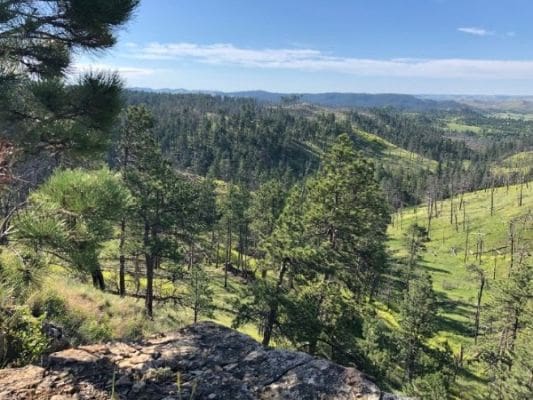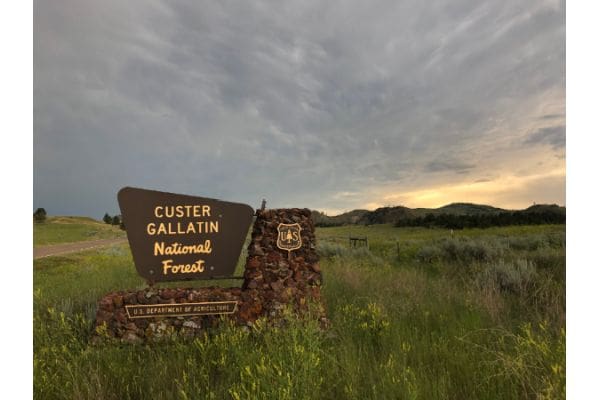The National Wild Turkey Federation and the USDA Forest Service are expanding their collaborative efforts in Montana to improve the health and resiliency of national forests in the Big Sky State. This partnership, established under the NWTF and Forest Service’s National Master Stewardship Agreement, will include two significant projects in Montana: The Bitterroot Front Project in the Bitterroot National Forest and the South Otter Landscape Restoration and Resiliency Project in the Custer Gallatin National Forest. Both projects are integral components of the national Wildfire Crisis Strategy, which seeks to safeguard communities from the threat of catastrophic wildfire, while also improving forest health and enhancing wildlife habitat.
“I am very excited about expanding the work we are doing with the Forest Service under our Master Stewardship Agreement to include work on the Bitterroot and Custer Gallatin National Forest,” said Molly Pitts, NWTF wildfire crisis manager. “These projects will provide significant benefits to wildlife such as elk, pronghorn, deer and turkey by increasing diversity of forage and cover types and reducing potential habitat loss from wildfires. These projects will also reduce the risk to communities and watersheds from catastrophic wildfires by reducing tree densities and the risk of mortality from insects and disease. With fire season still on-going in Montana, it is a good reminder about the importance and timeliness of this work.”
Bitterroot Front Project – Missoula, Montana
The Bitterroot Front Project is situated in the Stevensville and Darby-Sula Ranger Districts within the Bitterroot National Forest. The project area covers 143,344 acres of Forest Service lands in Ravalli County, Montana, including four of the 250 high-risk fire sheds identified in the WCS. These fire sheds are areas where wildfires pose a significant threat to nearby communities.
The project is divided into phases and operational areas, prioritizing those with the highest potential fire behavior risk to neighboring communities. The initial phase will involve comprehensive botany, soil and land surveys to assess the current conditions. Subsequent phases will focus on forest restoration improvements, administrative road upgrades, hazardous fuels reduction and other critical service work activities. “Hazardous fuels” is the term forest managers use to refer to the overly dense vegetation in a forest that can cause a fire to burn out of control. Reducing “fuels” in a forest greatly reduces the risk of catastrophic wildfire.
The primary objective of the Bitterroot Front Project is to mitigate wildfire risk to adjacent communities and promote forest restoration within these high-risk fire sheds. Efforts will include reducing fuel loading and arranging fuels to protect private properties in the Wildland-Urban Interface (areas where human development meets undeveloped wildland) and forested ecosystems that are susceptible to stand-replacing wildfires. Additionally, the project aims to restore forest stands affected by insects, disease and overstocked conditions, ultimately enhancing stand health and individual tree vigor, making them more resistant to future threats.
South Otter Landscape Restoration and Resiliency Project – Ashland, Montana
The South Otter Landscape Restoration and Resiliency Project is located in the Ashland District of the Custer Gallatin National Forest, spanning 2,754 acres of Forest Service lands in Powder River and Rosebud Counties.
Since 1995, nearly 60% of the Ashland landscape has been impacted by large wildfires. Notably, about one-third of the 292,000-acre area was affected by the Ash Creek and Taylor Creek Fires in 2012. The South Otter Project aims to reduce the risk of large-scale, high-severity wildfires by improving fire resiliency in ponderosa pine forested areas and enhancing overall biological and forest age diversity.
Project objectives include restoring ponderosa pine ecosystems to create more varied forested landscapes with diverse age and size structures, including old growth. The project will also focus on creating an understory structure resilient to natural disturbances such as fire, insects, disease and climate change. Additionally, the project aims to provide local jobs, services and forest products that support local and underserved communities.
A significant portion of the project area falls within the Powder River County and Rosebud County Community Wildfire Protection Plans. These plans guide the Forest Service in considering the potential effects on the Wildland-Urban Interface during fuel reduction programs. The project aims to safeguard critical assets—including water resources, powerlines, and roads within designated WUIs—to improve fire suppression efforts and alter fire behavior to help prevent catastrophic wildfires.

Learn more about the Wildfire Crisis Strategy and the relationship between wild turkeys and catastrophic wildfire prevention.
About the National Wild Turkey Federation
Since 1973, the National Wild Turkey Federation has invested over half a billion dollars into wildlife conservation and has positively impacted over 23 million acres of critical wildlife habitat. The NWTF has also invested over $10 million into wild turkey research to guide the management of the wild turkey population and to ensure sustainable populations into perpetuity. The organization continues to deliver its mission by working across boundaries on a landscape scale through its Four Shared Values: clean and abundant water, healthy forests and wildlife habitat, resilient communities, and robust recreational opportunities. With the help of its dedicated members, partners and staff, the NWTF continues its work to provide Healthy Habitats. and Healthy Harvests. for future generations.
Read the full article here




